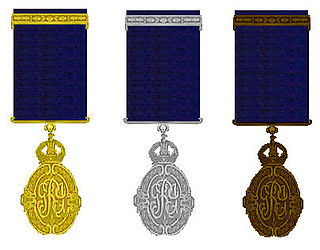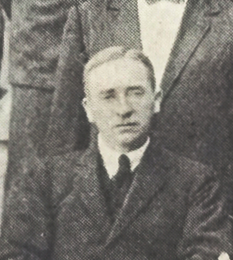Related Research Articles

Arthur MacArthur Jr. was a lieutenant general of the United States Army. He became the military Governor-General of the American-occupied Philippines in 1900; his term ended a year later due to clashes with the civilian governor, future-U.S. President William Howard Taft.

Alfred William Alcock was a British physician, naturalist, and carcinologist.

Frederick Marshman Bailey was a British political officer and one of the last protagonists of The Great Game. His expeditions in Tibet and Assam Himalaya gave him many opportunities to pursue his hobbies of photography, butterfly collecting, and trophy hunting in the high Tibetan region. Over 2000 of his bird specimens were presented to the Natural History Museum, although his personal collection is now held in the American Museum of Natural History, New York. His papers and extensive photograph collections are held in the British Library, London.

The Kaisar-i-Hind Medal for Public Service in India was a medal awarded by the Emperor/Empress of India between 1900 and 1947, to "any person without distinction of race, occupation, position, or sex ... who shall have distinguished himself by important and useful service in the advancement of the public interest in India."

Lieutenant Colonel Charles Donovan was an Irish physician, parasitologist and entomologist who served as a medical officer in the Indian Medical Service. He is best remembered for his discoveries of Leishmania donovani as the causative agent of visceral leishmaniasis, and Klebsiella granulomatis as that of donovanosis. The son of a judge in India, he was born in Calcutta and completed his primary education in India, and continued secondary school in Cork, Ireland. He graduated in medicine from Queen's College, Cork and joined the Indian Medical Service. He participated in British expeditions to Mandalay in Burma, Royapuram and Mangalore in India, Afghanistan, and finally Madras, where he spent the rest of his service. He was professor at Madras Medical College from 1898 until his retirement in 1919.

Major Richard William George Hingston was an Irish physician, explorer and naturalist who worked in India with the Indian Medical Service. He wrote several books based on his travels and natural history observations. He also served as medical officer to the 1924 British Mount Everest expedition.

Actumnus is a genus of crabs in the family Pilumnidae. Alongside the 28 extant species, it has a fossil record extending back into the Miocene.
Lieutenant-Colonel Robert Beresford Seymour Sewell CIE FRS FLS FZS was a British military doctor who served with the Indian Medical Service and served as a Surgeon Naturalist in the marine surveys, specialising on the taxonomy of copepods, and acted as an editor of The Fauna of British India, Including Ceylon and Burma 1933–1963.
Major-General James Alexander Deans Johnston, was a senior British Army officer in the Royal Army Medical Corps and the Senior Medical Officer at the liberated Bergen-Belsen concentration camp towards the end of the Second World War. A docudrama portraying his experiences attempting to save the starving and diseased concentration camp prisoners at Bergen-Belsen was made in 2007 entitled The Relief of Belsen.
Herbert Walton was an English surgeon and naturalist. Born in London on 19 January 1869, he was the second child and elder son of James Sydney Walton and Eleanor Georgina Louissan, his wife. Walton was initially educated in Paris, before entering private schools in England, culminating in Charterhouse (1881–84); he went on to study medicine at St Bartholomew's Hospital.
The New Year Honours 1914 were appointments by King George V to various orders and honours to reward and highlight good works by members of the British Empire. They were announced on 2 January 1914.
The 1892 Birthday Honours were appointments by Queen Victoria to various orders and honours to reward and highlight good works by citizens of the British Empire. The appointments were made to celebrate the official birthday of The Queen, and were published in the London Gazette on 24 May 1892 and in The Times on 25 May 1892.
The 1893 Birthday Honours were appointments by Queen Victoria to various orders and honours to reward and highlight good works by citizens of the British Empire. The appointments were made to celebrate the official birthday of The Queen, and were published in the London Gazette on 2 June 1893 and in The Times on 3 June 1893.
The 1918 New Year Honours were appointments by King George V to various orders and honours to reward and highlight good works by citizens of the British Empire. The appointments were published in The London Gazette and The Times in January, February and March 1918.

John Robertson Henderson CIE FRSE FZS FLS was a Scottish zoologist who specialized in the taxonomy of marine crustaceans, particularly the decapods, and worked on specimens collected by the oceanic research vessels Investigator and Challenger. From 1892 until 1911 he was Professor of Zoology at Madras Christian College in India. From 1908 to 1920 he was Superintendent of the Government Museum in Madras. He also took an interest in numismatics and Indian history.

Dysalotus alcocki is a species of deep sea fish, a swallower, from the family Chiasmodontidae which is found in the tropical and temperate oceans around the world. The adults fed mainly on fish. The juveniles and larvae are most frequently recorded from shallower waters while adults are mostly caught from depths of over 1,000 metres (3,300 ft). The generic name is derived from the Greek dysalotos which means "difficult to catch" and the specific name honours the English zoologist Alfred William Alcock (1859-1933).

Nathaniel H. Alcock was an Irish medical doctor.

Sir Thomas John Carey EvansMC FRCS was a Welsh surgeon who served as a doctor in the British army in India and as the first inspector of the British Postgraduate Medical School, when the school was founded at Hammersmith Hospital, London.
References
- ↑ "Archibald Currie McGilchrist". The University of Glasgow Story. University of Glasgow. Retrieved 15 June 2018.
- ↑ Lieutenant-Colonel D. G. Crawford (2012). Roll of the Indian Medical Service 1615-1930 - Volume 2. Andrews UK Limited. p. 507. ISBN 978-1781502310.
- ↑ MacGilchrist, Archibald Currie (1911). "Quinine and its salts : their solubility and absorbability".
{{cite journal}}: Cite journal requires|journal=(help) - ↑ "Orders, Decorations, Campaign Medals and Militaria". AuctionNet. Retrieved 15 June 2018.
- ↑ "The London Gazette June 30, 1903" (PDF). The Gazette. Retrieved 16 June 2018.
- 1 2 "Major Archibald Currie MacGilchrist". Lives of the First World War. Imperial War Museum. Retrieved 16 June 2018.
- ↑ "Army Lists". National Libraries of Scotland. Retrieved 16 June 2018.
- ↑ "China War Medal 1900, attributed, Indian Medical Service, officer". medal-medaille. Retrieved 16 June 2018.
- ↑ "Biographical Etymology of Marine Organism Names. M". Hans G. Hansson. Retrieved 16 June 2018.
- ↑ Patsy McLaughlin, ed. (2009). "Bathycheles macgilchristi (Alcock, 1905)". WoRMS. World Register of Marine Species . Retrieved 16 June 2018.
- ↑ A. C. MacGilchrist Surgeon-Naturalist to the Survey M.A., M.B., Ch.B., Capt. I.M.S. (1905). "XXVIII.—Natural History Notes from the R.I.M.S. 'Investigator,' Capt. T. H. Heming, R. N. (retired), commanding.—Series III., No. 6. An Account of the new and some of the rarer Decapod Crustacea obtained during the Surveying Seasons 1901–1904". Annals and Magazine of Natural History. Series 7. 15 (87): 233–268. doi:10.1080/03745480509443038.
{{cite journal}}: CS1 maint: multiple names: authors list (link) - ↑ MacGilchrist, A. C. (1905). "Natural history notes from the R. I. M. S. 'Investigator,' Capt. T. H. Heming, R. N. (retired), commanding.--Series III., No. 8. On a new genus of teleostean fish closely allied to Chiasmodus". Annals and Magazine of Natural History. Series 7. 15 (87): 268–270. doi:10.1080/03745480509443039.